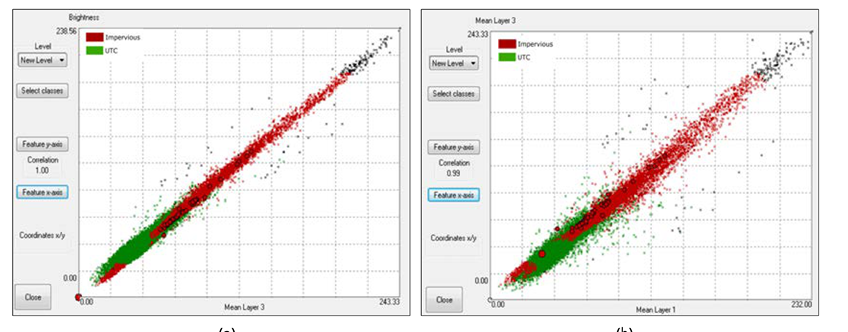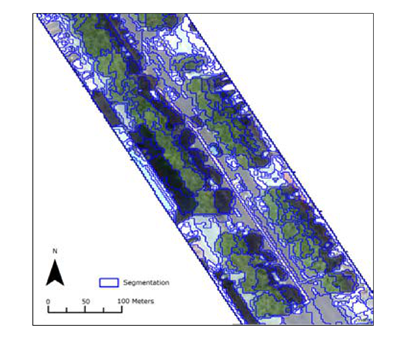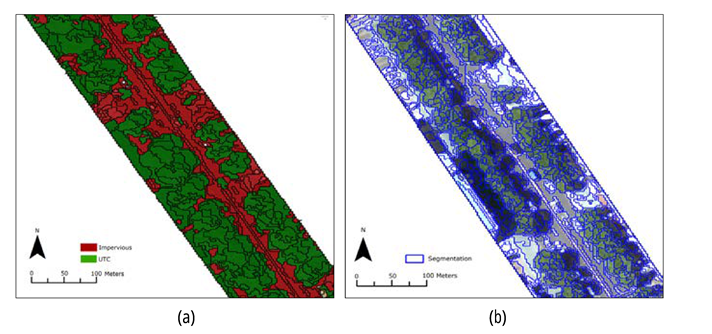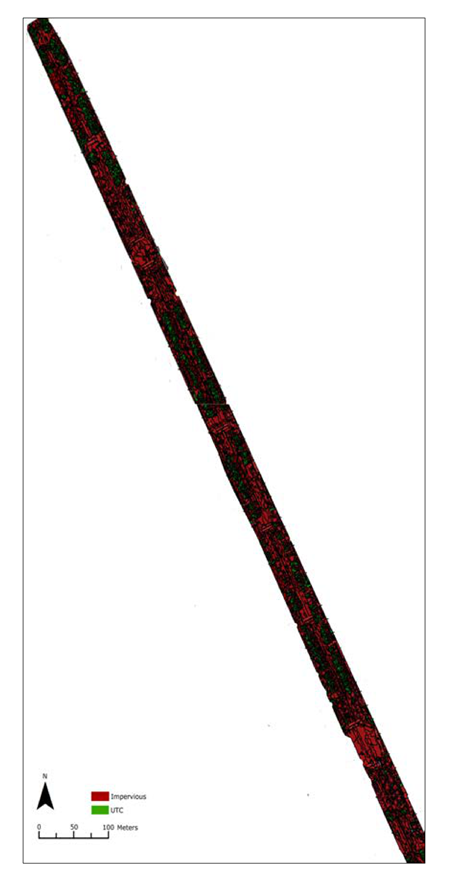Anderson J.J., Cobb N.S.. 2004;Tree cover discrimination in panchromatic aerial imagery of pinyon-juniper woodlands. Photogrammetric Engi. Remote Sens. 70(9): 1063–1068. PMID:
10.14358/pers.70.9.1063. .

Baatz M., Sch A.. 2000;Multiresolution segmentation: an optimization approach for high quality multi-scale image segmentation. Angewandte Geographische Informationsverarbeitung XII. Beiträge zum AGIT-Symposium Salzburg 2000 12–23. PMID:
10.1007/978-3-642-47355-5. .
Bwangoy J.R, Matthew C.H., David P.R., Gianfranco De G, Christopher O.J.. 2010;Wetland mapping in the Congo basin using optical and radar remotely sensed data and derived topographical indices. Remote Sens. Environ. 114(1): 73–86. PMID:
10.1016/j.rse.2009.08.004. .

City of Vancouver. 2011;Vancouver 2011 urban tree canopy assessment report. Washington, Canada: PMID:
PMC3357861. .
Congalton R.G. 1991;A review of assessing the accuracy of classifications of remotely sensed data. Remote Sens. Environ. 37(1): 35–46. PMID:
10.1016/0034-4257(91)90048-b. .

Congalton R.G, Birch K., Jones R., Schriever J.. 2002;Evaluating remotely sensed techniques for mapping riparian vegetation. Computers and Electron. Agri. 37(1): 113–126. PMID:
10.1016/s0168-1699(02)00108-4. .

Congalton R.G., Green K.. 2009;Sample Design Consideration. 63–84. R.G. Congalton and K. Green. Assessing the accuracy of remotely sensed data: principles and practices. 2nd ed. CRC press; Boca Raton, USA: PMID:
10.1201/9781420048568. .
Ferrato L.J., Forsythe K.W.. 2013;Comparing hyperspectral and multispectral imagery for land classification of the Lower Don River, Toronto. J. Geography and Geology. 5(1):92-107. J. Geography and Geology. 5(1): 92–107. PMID:
10.5539/jgg.v5n1p92. .
Gong P., Howarth P.. 1990;The use of structural information for improving land-cover classification accuracies at the rural-urban fringe. Photogrammetric Engi. Remote sens. 56(1): 67–73. .
Hodson M., Marvin S.. 2010;Urbanism in the anthropocene: ecological urbanism or premium ecological enclaves? City. 14(3):298-313. City 14(3): 298–313. PMID:
10.1080/13604813.2010.482277. .

Irani F.M., Galvin M.F.. 2003;Strategic urban forests assessment: Baltimore, Maryland. Proc. ASPRS 85–94. .
Jensen J.R. 2005;Introductory digital image processing: a remote sensing perspective . 3rd ed. Prentice Hall, United States of America.. .

Killicoat P, Puzio E., Stringer R.. 2002;The economic value of trees in urban areas: estimating the benefits of Adelaide’s street trees. Proc. 3rd Nat. Street Tree Symposium Adelaide Univ, Australia. 90–102. .
Laliberte A.S, Koppa J., Fredrickson E. L., Rango A.. 2006;Comparison of nearest neighbor and rule-based decision tree classification in an object-oriented environment. In IEEE Int. Geo. Remote Sens. In IEEE Int. Geo. Remote Sens. .
Loughner C.P, Allen D.J., Zhang D.L., Pickering K.E., Dickerson R.R., Landry L.. 2012;Roles of urban tree canopy and buildings in urban heat island effects: parameterization and preliminary results. J. Applied Meteo. Climat. 51(10): 1775–1793. .

McPherson E.G, Simpson J.R., Xiao Q., Wu C.. 2008;Los Angeles 1-million tree canopy cover assessment. USDA .

Motohka T, Nasahara K.N., Oguma H., Tsuchida S.. 2010;Applicability of green-red vegetation index for remote sensing of vegetation phenology. Remote Sens. 2(10): 2369–2387. .

Myeong S, Hopkins P.F., Nowak D.J.. 2001;Urban cover mapping using digital, high-spatial resolution aerial imagery. Urban Ecosys. 5:243-256. Urban Ecosys 5:243–256. .

Park J. 2013;Air temperature reduction effects of small green spaces in urban blocks of Seoul, Korea. PhD Diss. Seoul Nat. Univ., Seoul, South Korea: .
Sander H, Polasky S., Haight R.G.. 2010;The value of urban tree cover: A hedonic property price model in Ramsey and Dakota Counties, Minnesota, USA. Ecol. Econo. 69(8): 1646–1656. .

Simpson J.R., McPherson E.G.. 1996;Estimating urban forest impacts on climate-mediated residential energy use. In Conference on Agri. Forest Meteo In: Symposium on Fire and Forest Meteo; 22:462–465. .
Stehman S.V., Czaplewski R.L.. 2003;Introduction to special issue on map accuracy. Environ. Ecol. Stat. 10(3): 301–308. .

Tallis M, Taylor G., Sinnett D., Freer P.. 2001;Estimating the removal of atmospheric particulate pollution by the urban tree canopy of London, under current and future environments. Landscape and Urban Planning 103(2): 129–138. .

L Tyrväinen,. 2001;Economic valuation of urban forest benefits in Finland. J. Environ. Manag. 62(1): 75–92. .

Walton J.T, Nowak D.J., Greenfield E.J.. 2008;Assessing urban forest canopy cover using airborne or satellite imagery. Arbori. Urban Forestry. 34(6): 334–340. .

Zhang Y. 2001;“Texture-integrated classification of urban treed areas in high-resolution color-infrared imagery”. Photogrammetric Engi. Remote Sens. 67:1359–1365. .
Zhou W, Troy A.. 2008;An object‐oriented approach for analysing and characterizing urban landscape at the parcel level. Int. J. Remote Sens. 29(11): 3119–3135. .

















